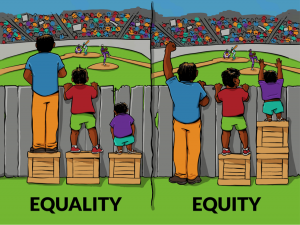
August 09, 2017 | By Michelle A. Leak, EdD, MBA and Yashika J. Watkins, PhD, MPH
One Size Does Not Fit All
Why is this illustration important?
It depicts the importance of achieving equity, which is key to producing the most optimal health outcomes possible. Health equity includes the absence of disparities in health, healthcare, health status, and the living and working conditions that impact health. The Race Matters Institute describes, “The route to achieving equity will not be accomplished through treating everyone equally. It will be achieved by treating everyone equitably, or justly according to their circumstances.” In other words, achieving health equity does not include a ‘one size fits all’ approach; rather, it includes a sized approach — one that is sized according to each person’s needs.
What does the ‘one size does not fit all’ approach mean for musculoskeletal health disparities?
Health disparities are used to measure progress toward achieving health equity. Given this, it is assumed that as health equity improves, health disparities will diminish. Yet, health disparities specific to musculoskeletal health are increasing. With increasing rates of arthritis diagnosis, disparities in arthritis and functional limitations are highest by gender (i.e., women) and by race (i.e., African Americans) and ethnicity (i.e., Hispanic/Latinos).
How can we together make an impact on musculoskeletal disparities?
One way is to recognize and understand that neither health equity nor the elimination of musculoskeletal health care disparities can be achieved without a redistribution of resources tailored to the needs of individual patients and healthcare consumers. As depicted in the illustration, the “box” represents the “resource.” Only when the resource is redistributed and tailored to the needs of each individual, is equity achieved. In healthcare, this means and calls for a fundamental shift in how health care resources are distributed and accessed — those that need more will get more; the quality of care will be the same for all; and care will be affordable.
Another way to make an impact on musculoskeletal disparities is to join the movement and learn about Movement is Life (https://www.movementislifecommunity.org/). Movement is Life is the leader in addressing musculoskeletal health disparities. The organization has suggestions for ways to get involved, ways to promote health equity, and resources to support those efforts. Join them in sounding the alarm to providers and policymakers that there is no such thing as ‘one size fits all’ health care or care that is equal. Rather, the best health care is care that is accessible and tailored to the needs of each individual patient.
CATEGORIES: , Exercise Guidelines, Healthcare Disparity, Mindfulness, Obesity, Physical Activity